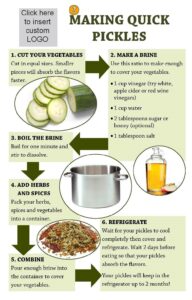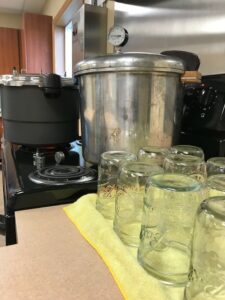
During my first year as a fully trained OSU Extension Master Food Preserver (MFP) volunteer, I also interned at Zenger Farm as part of a CSA Partnership for Health (CSAP4H) pilot program. And none of my friends knew what the heck that meant.
Understanding acronyms is like knowing another language. Recently, I received feedback that when sharing a new topic or idea, it’s important to take a couple of (big) steps backwards. Sometimes I’m so close to a topic, I skip the basics.
Who is OSU Extension and what do they do? (And why should you care? Um…free science-based resources? Yes, please!) What do Master Food Preservers do, and how are they connected to the Family and Community Health (FCH) program? And what is the CSA Partnership for Health program? In fact, what is a CSA? Excellent questions.
So, Buckle Up Buttercup, let’s talk about this.
Oregon State University (OSU) Extension:
OSU Extension engages the people of Oregon with research-based knowledge and education. Extension programs include 4-H, Forestry, Horticulture (Master Gardeners), and Family and Community Health (FCH), to name a few. Master Food Preservers (MFP) and the SNAP Education program exist under the FCH umbrella. Volunteers participate in an intensive volunteer training program and pay back their training through volunteer service. They make food safety and food preservation recommendations to the public and provide education through classes and public events like farmer’s markets, emergency prep fairs, and other community events. Clackamas County MFP training also includes nutrition and food resource management, partnering with food banks, schools, and the community to deliver nutrition programming.

More on that later.
A Community Supported Agriculture (CSA), as mentioned in Meet Me In the Pawpaw Patch, is a trust relationship between a person and a farmer.

Investing in a farm at the beginning of the season (like now) helps pay for seeds, soil amendments, and infrastructure, like repairing a hoop house damaged by the recent ice storm. Farms don’t produce many crops to sell this time of year, so they repay the investment by providing a share of their crop later, during the growing season. Some folks find their farms through a friend, online, farmer’s markets, or through events like the PNW CSA Share Fair.
It used to be that you had to come up with at least half, if not all, of a CSA payment at the beginning of the season, but nowadays payment schedules are more flexible. Some farms are even set up to receive monthly payment with EBT.
What is EBT?
Electronic Benefits Transfer, EBT is the debit-style card used as a form of payment for folks receiving SNAP benefits, formerly known as food stamps.
What is SNAP and what does it do in addition to paying for food?

The Supplemental Nutrition Assistance Program (SNAP) provides nutrition benefits for individuals and families in need. Did you know that if you receive SNAP benefits, you also qualify for other resources, such a Double Up Food Bucks (DUFB)? SNAP-Education is under the umbrella of OSU’s FCH program and through classes and programs like Kids in the Kitchen and MyPlate, teach students and adults about eating healthy. Food Hero is a resource of healthy, tasty, and easy to prepare recipes. Many of the recipes are simple enough for children to make.
So yeah…that’s cool. 🙂
CSA Partnership for Health Program
CSA Partnership for Health began as a pilot in 2015 with the nonprofit urban farm, Zenger Farm. The goal was to see if increased consumption of fruits and vegetables, paired with education on healthy eating, would have an impact on patient’s health.

Patients arrive at their home clinic each week to pick up fresh vegetables, taste healthy recipes, learn new ways to prepare produce, and build support networks. The program supports individual health, the prosperity of our local food system, and works with insurers to one day provide coverage for fresh fruits and vegetables, just like prescription medication. Patients pay a $5 weekly co-pay (in cash or SNAP) for a 22-week prescription of vegetables and whole grains. At the time I interned, we contributed to a series of skill sheets, highlighting some common cooking methods. The CSAP4H program is still operating, and helping folks connect fruits and vegetables with better health, while addressing the root causes of food access and disease. It’s a beautiful thing.
Farmers Market Fund’s Double Up Food Bucks program.
It matches up to $10 SNAP dollars spent weekly on fruits and vegetables at farmers markets across Oregon. $10+$10=$20! Double Up helps low-income folks bring home more fresh produce, small farmers get an economic boost, and local economies thrive.
How does this tie into OSU’s FCH program and Master Food Preservers?
In 2016, our fearless leader, OSU Extension’s Clackamas County Family and Community Health faculty and senior instructor, Kelly Streit, developed SNAP-To-It!, a farmer’s market tour followed by a Food Hero cooking demonstration featuring ingredients sourced at the farmer’s market. The SNAP-Ed Program is partnering with Double Up Food Bucks to deliver more SNAP-To-It! programming. The partnerships will be at select farmer’s markets, small grocery stores, and CSA farms in select regions across the state.

Remember the Zenger farm skill sheets? MFP volunteers are working on creating skill sheets on additional topics, such as: Making a green sauce, how to store fresh herbs, unusual root vegetables, and other topics helpful to CSA and DUFB members.
So, stay tuned.
And as always my friends, keep up the good work. There’s light at the end of this tunnel. You can do it.
Stay curious and be excellent to each other.
Buffy Rhoades| mom. forager. gardener. volunteer turned program assistant. a real busy beaver




